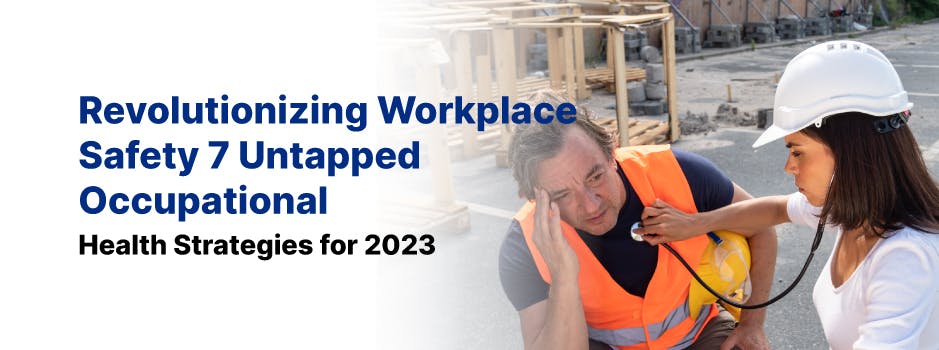Introduction
Occupational safety and health (OSH) has always been critical to maintaining a productive and efficient work environment. As we progress into 2023, businesses must continually adapt and innovate to ensure their employees are safe and protected from potential hazards. This not only benefits the well-being of employees but also boosts overall company performance.
This article will explore seven untapped occupational health strategies that can revolutionize workplace safety in 2023. These cutting-edge approaches will enable companies to stay ahead of the curve and promote a culture of safety and wellness in their workplaces.
Wearable Technology for Real-Time Health Monitoring
Wearable technology has seen significant advancements recently, with devices such as smartwatches and fitness trackers becoming commonplace. Companies can leverage this technology for real-time health monitoring, allowing them to track and analyze employee health data to identify and address potential risks proactively.
For instance, wearables can monitor vital signs, detect signs of fatigue, and assess ergonomic risk factors. This information can help companies to make informed decisions about their employees' workload, schedules, and workplace design, ultimately reducing the likelihood of accidents and injuries.
Virtual Reality (VR) Training for Hazard Identification and Prevention
Virtual reality (VR) technology has tremendous potential in workplace safety training. By creating immersive and realistic scenarios, companies can train their employees to identify hazards and practice safe work procedures in a controlled environment. This allows workers to gain valuable experience and build their confidence in handling dangerous situations without facing real-life risks.
In addition to improving hazard identification and prevention, VR training can also reduce training costs and improve knowledge retention rates, making it a highly effective and innovative approach to occupational safety and health.
Predictive Analytics for Accident Prevention
With the rise of big data and machine learning, predictive analytics can be utilized to identify trends and patterns in workplace accidents and incidents. By analyzing historical data, companies can identify the root causes of accidents and develop targeted interventions to prevent them from reoccurring.
For example, predictive analytics can help identify patterns of equipment failure or human error that may lead to accidents. Companies can then take preventive measures, such as implementing regular equipment inspections, updating safety procedures, or providing additional training to employees.
Integrating Mental Health into Occupational Health Programs
Traditionally, occupational health programs have focused primarily on physical safety. However, the importance of mental health in the workplace cannot be overstated. Stress, anxiety, and burnout can significantly impact employee productivity and increase the risk of accidents.
Companies must integrate mental health into their OSH programs to revolutionize workplace safety. This can be achieved by offering mental health support services, promoting work-life balance, and fostering a supportive work culture. By addressing mental health concerns, companies can create a safer and more productive work environment for their employees.
Gamification of Workplace Safety Training
Gamification is the application of game design principles to non-game contexts, such as workplace safety training. By making training more engaging and enjoyable, gamification can increase employee motivation and participation, ultimately leading to better knowledge retention and improved safety performance.
Companies can incorporate gamification into their safety training programs through leaderboards, badges, and reward systems. Creating a competitive and fun environment makes employees more likely to participate in training and adopt safe work practices actively.
Adopting a Holistic Approach to Workplace Wellness
A holistic approach to workplace wellness involves addressing all aspects of employee well-being, including physical, mental, and social health. Companies can implement comprehensive wellness programs that include regular health screenings, fitness classes, mental health support services, and social activities.
By promoting overall wellness, companies can improve employee health and reduce the risk of workplace accidents and injuries. A healthy and happy workforce is more likely to be engaged, productive, and committed to maintaining a safe work environment.
Building a Culture of Safety Through Employee Empowerment
Employee empowerment is a powerful strategy for revolutionizing workplace safety. By involving employees in the development and implementation of safety policies and procedures, companies can foster a sense of ownership and accountability among their workforce.
To achieve this, companies can establish safety committees with employee representatives, encourage open communication about safety concerns, and provide opportunities for employees to participate in safety training and audits. By empowering employees to take an active role in maintaining a safe work environment, companies can create a strong culture of safety that extends beyond policies and procedures.
Conclusion
As we move forward into 2023, it is crucial for businesses to stay ahead of the curve and adopt innovative strategies to promote occupational safety and health. By implementing these seven untapped strategies, companies can revolutionize workplace safety and protect their employees from potential hazards.
By investing in wearable technology, utilizing virtual reality training, leveraging predictive analytics, integrating mental health into OSH programs, incorporating gamification, adopting a holistic approach to wellness, and empowering employees, businesses can create a safer, healthier, and more productive work environment. Ultimately, these strategies will reduce workplace accidents, improve employee well-being, and increase overall company performance.


